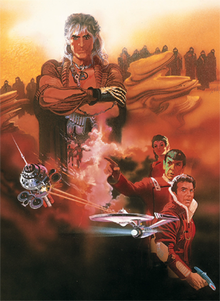Historical Context and Release
On June 4, 1982, ‘Star Trek II: The Wrath of Khan’ premiered in the United States, marking a pivotal moment in the ‘Star Trek’ franchise. Directed by Nicholas Meyer, the film was a sequel to the original ‘Star Trek: The Motion Picture’ released in 1979. The state of the franchise at the time was one of cautious optimism; while the first film had achieved commercial success, it received mixed reviews, prompting a re-evaluation of the series’ direction. The return of Ricardo Montalbán as the infamous Khan Noonien Singh, a character originally introduced in the 1967 ‘Star Trek’ episode ‘Space Seed,’ was a strategic move to revive interest and connect the sequel to the beloved television series.
The production of ‘Star Trek II: The Wrath of Khan’ faced several challenges, including budget constraints and the need to deliver a compelling story that would resonate with both old fans and new audiences. Nicholas Meyer, although not initially a ‘Star Trek’ aficionado, was brought in to direct and substantially rewrite the script. His fresh perspective and innovative approach were instrumental in crafting a narrative that balanced character development with action and suspense.
The anticipation surrounding the film’s release was palpable, fueled by a robust marketing campaign and the enduring popularity of the ‘Star Trek’ brand. Initial critical reception was largely positive, with many praising the film’s emotional depth and the strong performances of its cast, particularly Montalbán’s portrayal of Khan Noonien Singh. This acclaim was mirrored at the box office, where the film performed robustly, becoming a commercial success and cementing its legacy within the ‘Star Trek’ canon.
According to film archives and interviews with the cast and crew, the release of ‘Star Trek II: The Wrath of Khan’ on June 4, 1982, not only rejuvenated the franchise but also set a new standard for science fiction films of the era. Its success demonstrated the viability of the ‘Star Trek’ universe on the big screen, paving the way for subsequent films and series that continued to explore the final frontier.
Impact and Legacy
Released on 4th June 1982, “Star Trek II: The Wrath of Khan” has left an indelible mark on both the “Star Trek” franchise and popular culture at large. Widely celebrated for its compelling story and character development, the film introduced a level of emotional depth that resonated profoundly with audiences. The narrative, centered on themes of revenge, sacrifice, and the passage of time, offered a mature and thoughtful exploration of its characters, particularly the dynamic between Captain Kirk and his nemesis, Khan Noonien Singh.
The film’s thrilling action sequences, combined with its emotional gravity, set a new standard for science fiction cinema. The climactic battle in the Mutara Nebula, for instance, remains a hallmark of tension and strategic warfare in film. This combination of intellect and action helped to revitalize the “Star Trek” franchise, ushering in a new era of storytelling that balanced philosophical inquiry with visceral excitement.
Critically, “Star Trek II: The Wrath of Khan” received widespread acclaim. Many reviewers praised its return to the core elements of the original series, emphasizing character-driven plots and ethical dilemmas. Scholarly articles have analyzed its thematic richness, often highlighting the film’s exploration of mortality and leadership. Fan reviews continue to laud its enduring appeal, with many considering it the quintessential “Star Trek” movie.
The movie’s success had a ripple effect, leading to a resurgence of interest in “Star Trek” and paving the way for subsequent films and television series. The critical acclaim and box office success of “Star Trek II: The Wrath of Khan” demonstrated the franchise’s potential for longevity and reinvention. It became a touchstone for future “Star Trek” endeavors, influencing everything from narrative structure to character arcs in later installments.
In summary, the impact and legacy of “Star Trek II: The Wrath of Khan” cannot be overstated. Its compelling story, character development, thrilling action sequences, and emotional depth have secured its place as a cornerstone of the “Star Trek” legacy. The film’s influence continues to be felt, underscoring its importance in the annals of science fiction and popular culture.

